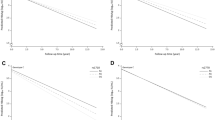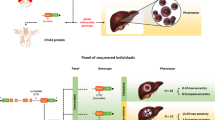Abstract
The cytokine tumor necrosis factor alpha (TNF-α) is important in generating an immune response against a hepatitis C virus (HCV) infection. The functions of TNF-α may be altered by single-nucleotide polymorphisms (SNPs) in its gene, TNF. We hypothesized that SNPs in TNF may be important in determining the outcome of an HCV infection. To test this hypothesis, we typed nine TNF SNPs in a cohort of individuals with well-defined HCV outcomes. Three of these SNPs were typed in a second cohort. Data were analyzed using logistic regression stratifying by ethnicity, since rates of HCV clearance differ in black subjects versus white subjects. The SNP −863A was associated with viral clearance in black subjects (odds ratios (OR) 0.52, 95% confidence interval (CI) 0.29–0.93). Furthermore, the common wild-type haplotype −863C/−308G was associated with viral persistence in black subjects (OR 1.91, 95% CI 1.24–2.95). These findings were independent of linkage with human leukocyte antigen (HLA) alleles. Further study of this polymorphism and haplotype is needed to understand these associations and the role of TNF-α in determining outcomes of HCV infection.
This is a preview of subscription content, access via your institution
Access options
Subscribe to this journal
Receive 6 digital issues and online access to articles
$119.00 per year
only $19.83 per issue
Buy this article
- Purchase on Springer Link
- Instant access to full article PDF
Prices may be subject to local taxes which are calculated during checkout
Similar content being viewed by others
References
Anonymous. National Institutes of Health Consensus Development Conference Panel statement: management of hepatitis C. Hepatology 1997; 26: 2S–10S.
Villano SA, Vlahov D, Nelson KE, Cohn S, Thomas DL . Persistence of viremia and the importance of long-term follow-up after acute hepatitis C infection. Hepatology 1999; 29: 908–914.
Cooper S, Erickson AL, Adams EJ et al. Analysis of a successful immune response against hepatitis C virus. Immunity 1999; 10: 439–449.
Rehermann B, Chang KM, McHutchison J et al. Differential cytotoxic T-lymphocyte responsiveness to the hepatitis B and C viruses in chronically infected patients. J Virol 1996; 70: 7092–7102.
Thio CL, Thomas DL, Goedert JJ et al. Racial differences in HLA class II associations with hepatitis C virus outcomes. J Infect Dis 2001; 184: 16–21.
Thio CL, Gao X, Goedert JJ et al. HLA-Cw*04 and hepatitis C virus persistence. J Virol 2002; 76: 4792–4797.
Thursz M, Yallop R, Goldin R, Trepo C, Thomas HC . Influence of MHC class II genotype on outcome of infection with hepatitis C virus. The HENCORE group. Hepatitis C European Network for Cooperative Research. Lancet 1999; 354: 2119–2124.
Vassalli P . The pathophysiology of tumor necrosis factors. Annu Rev Immunol 1992; 10: 411–452.
Koziel MJ, Dudley D, Afdhal N et al. HLA class I-restricted cytotoxic T lymphocytes specific for hepatitis C virus – identification of multiple epitopes and characterization of patterns of cytokine release. J Clin Invest 1995; 96: 2311–2321.
Nelson DR, Lim HL, Marousis CG et al. Activation of tumor necrosis factor-alpha system in chronic hepatitis C virus infection. Dig Dis Sci 1997; 42: 2487–2494.
Gonzalez-Amaro R, Garcia-Monzon C, Garcia-Buey L et al. Induction of tumor necrosis factor alpha production by human hepatocytes in chronic viral hepatitis. J Exp Med 1994; 179: 841–848.
Larrea E, Garcia N, Qian C, Civeira MP, Prieto J . Tumor necrosis factor alpha gene expression and the response to interferon in chronic hepatitis C. Hepatology 1996; 23: 210–217.
Lio D, Caruso C, Di Stefano R et al. IL-10 and TNF-alpha polymorphisms and the recovery from HCV infection. Hum Immunol 2003; 64: 674–680.
Constantini PK, Wawrzynowicz-Syczewska R, Clare M et al. Interleukin-1, interleukin-10 and tumour necrosis factor-alpha gene polymorphisms in hepatitis C virus infection: an investigation of the relationships with spontaneous viral clearance and response to alpha-interferon therapy. Liver 2002; 22: 404–412.
Hohler T, Kruger A, Gerken G et al. Tumor necrosis factor alpha promoter polymorphism at position −238 is associated with chronic active hepatitis C infection. J Med Virol 1998; 54: 173–177.
Yee LJ, Tang J, Herrera J, Kaslow RA, van Leeuwen DJ . Tumor necrosis factor gene polymorphisms in patients with cirrhosis from chronic hepatitis C virus infection. Genes Immun 2000; 1: 386–390.
Vidigal PG, Germer JJ, Zein NN . Polymorphisms in the interleukin-10, tumor necrosis factor-alpha, and transforming growth factor-beta1 genes in chronic hepatitis C patients treated with interferon and ribavirin. J Hepatol 2002; 36: 271–277.
Schiemann U, Glas J, Torok P et al. Response to combination therapy with interferon alfa-2a and ribavirin in chronic hepatitis C according to a TNF-alpha promoter polymorphism. Digestion 2003; 68: 1–4.
Negoro K, Kinouchi Y, Hiwatashi N et al. Crohn's disease is associated with novel polymorphisms in the 5′-flanking region of the tumor necrosis factor gene. Gastroenterology 1999; 117: 1062–1068.
Seki N, Yamaguchi K, Yamada A et al. Polymorphism of the 5′-flanking region of the tumor necrosis factor (TNF)-alpha gene and susceptibility to human T-cell lymphotropic virus type I (HTLV-I) uveitis. J Infect Dis 1999; 180: 880–883.
Barrett S, Collins M, Kenny C et al. Polymorphisms in tumour necrosis factor-alpha, transforming growth factor-beta, interleukin-10, interleukin-6, interferon-gamma, and outcome of hepatitis C virus infection. J Med Virol 2003; 71: 212–218.
Rosen HR, McHutchison JG, Conrad AJ et al. Tumor necrosis factor genetic polymorphisms and response to antiviral therapy in patients with chronic hepatitis C. Am J Gastroenterol 2002; 97: 714–720.
Yee LJ, Tang J, Gibson AW et al. Interleukin 10 polymorphisms as predictors of sustained response in antiviral therapy for chronic hepatitis C infection. Hepatology 2001; 33: 708–712.
Skoog T, van't Hooft FM, Kallin B et al. A common functional polymorphism (C → A substitution at position −863) in the promoter region of the tumour necrosis factor-alpha (TNF-alpha) gene associated with reduced circulating levels of TNF-alpha. Hum Mol Genet 1999; 8: 1443–1449.
Higuchi T, Seki N, Kamizono S et al. Polymorphism of the 5′-flanking region of the human tumor necrosis factor (TNF)-alpha gene in Japanese. Tissue Antigens 1998; 51: 605–612.
Uglialoro AM, Turbay D, Pesavento PA et al. Identification of three new single nucleotide polymorphisms in the human tumor necrosis factor-alpha gene promoter. Tissue Antigens 1998; 52: 359–367.
Hohjoh H, Tokunaga K . Allele-specific binding of the ubiquitous transcription factor OCT-1 to the functional single nucleotide polymorphism (SNP) sites in the tumor necrosis factor-alpha gene (TNFA) promoter. Genes Immun 2001; 2: 105–109.
Udalova IA, Richardson A, Denys A et al. Functional consequences of a polymorphism affecting NF-kappaB p50–p50 binding to the TNF promoter region. Mol Cell Biol 2000; 20: 9113–9119.
Barnes PJ, Karin M . Nuclear factor-kappaB: a pivotal transcription factor in chronic inflammatory diseases. N Engl J Med 1997; 336: 1066–1071.
Louis E, Franchimont D, Piron A et al. Tumour necrosis factor (TNF) gene polymorphism influences TNF-alpha production in lipopolysaccharide (LPS)-stimulated whole blood cell culture in healthy humans. Clin Exp Immunol 1998; 113: 401–406.
Danis VA, Millington M, Hyland V et al. Increased frequency of the uncommon allele of a tumour necrosis factor alpha gene polymorphism in rheumatoid arthritis and systemic lupus erythematosus. Dis Markers 1995; 12: 127–133.
Huizinga TW, Westendorp RG, Bollen EL et al. TNF-alpha promoter polymorphisms, production and susceptibility to multiple sclerosis in different groups of patients. J Neuroimmunol 1997; 72: 149–153.
Wilson AG, Symons JA, McDowell TL, McDevitt HO, Duff GW . Effects of a polymorphism in the human tumor necrosis factor alpha promoter on transcriptional activation. Proc Natl Acad Sci USA 1997; 94: 3195–3199.
Brinkman BM, Zuijdeest D, Kaijzel EL, Breedveld FC, Verweij CL . Relevance of the tumor necrosis factor alpha (TNF alpha) −308 promoter polymorphism in TNF alpha gene regulation. J Inflamm 1995; 46: 32–41.
Thomas DL, Astemborski J, Rai RM et al. The natural history of hepatitis C virus infection: host, viral, and environmental factors. JAMA 2000; 284: 450–456.
Villano SA, Vlahov D, Nelson KE et al. Incidence and risk factors for hepatitis C among injection drug users in Baltimore, Maryland. J Clin Microbiol 1997; 35: 3274–3277.
Thomas DL, Vlahov D, Solomon L et al. Correlates of hepatitis C virus infections among injection drug users in Baltimore. Medicine 1995; 74: 212–220.
Vlahov D, Anthony JC, Munoz A et al. The ALIVE study, a longitudinal study of HIV-1 infection in intravenous drug users: description of methods and characteristics of participants. NIDA Res Monogr 1991; 109: 75–100.
Goedert JJ, Kessler CM, Aledort LM et al. A prospective study of human immunodeficiency virus type 1 infection and the development of AIDS in subjects with hemophilia. N Engl J Med 1989; 321: 1141–1148.
Hilgartner MW, Donfield SM, Willoughby A et al. Hemophilia growth and development study. Design, methods, and entry data. Am J Pediatr Hematol Oncol 1993; 15: 208–218.
Richardson A, Sisay-Joof F, Ackerman H et al. Nucleotide diversity of the TNF gene region in an African village. Genes Immun 2001; 2: 343–348.
Stephens M, Smith NJ, Donnelly P . A new statistical method for haplotype reconstruction from population data. Am J Hum Genet 2001; 68: 978–989.
Acknowledgements
This work was supported by NIH Grants DA00441, DA12568, DA04334, DA13324, and DK56415. MHCS is supported by National Cancer Institute Contract N01-CP-33002 with Research Triangle Institute. This project has been funded in whole or in part with Federal funds from the National Cancer Institute, National Institutes of Health, under Contract no NO1-CO-12400. The publisher or recipient acknowledges rights of the US Government to retain a nonexclusive, royalty-free license in, and to any copyright covering the article. We thank the study subjects for participating in this study.
Author information
Authors and Affiliations
Corresponding author
Rights and permissions
About this article
Cite this article
Thio, C., Goedert, J., Mosbruger, T. et al. An analysis of tumor necrosis factor α gene polymorphisms and haplotypes with natural clearance of hepatitis C virus infection. Genes Immun 5, 294–300 (2004). https://doi.org/10.1038/sj.gene.6364072
Received:
Revised:
Accepted:
Published:
Issue Date:
DOI: https://doi.org/10.1038/sj.gene.6364072
Keywords
This article is cited by
-
TNF-α promoter polymorphism: a factor contributing to the different immunological and clinical phenotypes in Japanese encephalitis
BMC Infectious Diseases (2012)
-
IL28B: Implications for Therapy
Current Hepatitis Reports (2011)
-
Hepatitis C inflection in dialysis patients: a link to poor clinical outcome?
International Urology and Nephrology (2007)
-
Patterns of nucleotide sequence variation in ICAM1 and TNF genes in twelve ethnic groups of India: roles of demographic history and natural selection
Journal of Genetics (2007)
-
Single nucleotide polymorphisms and haplotypes in the IL10 region associated with HCV clearance
Genes & Immunity (2005)



